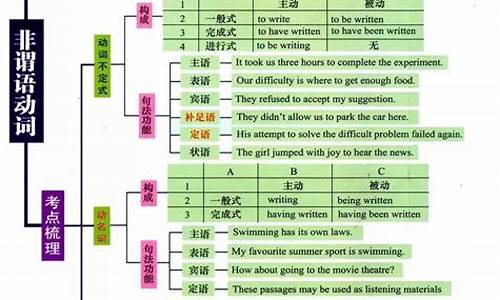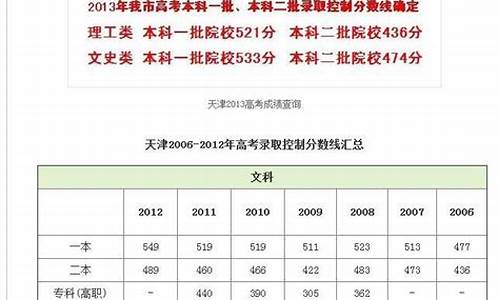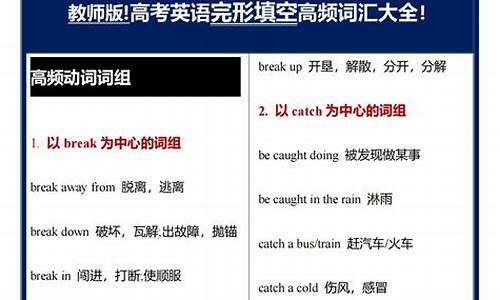您现在的位置是: 首页 > 招生信息 招生信息
英语高考语法点_高考英语语法重点
tamoadmin 2024-05-25 人已围观
简介1.高考英语语法: 英语分词的逻辑主语2.高中英语语法,大师帮帮忙噢3.高考英语必备的语法知识点4.高考英语语法题目类型和分布重点5.高考英语语法:高中英语语法-插入语六大用法小结6.高中语法重点是什么?识在于积累、学习在于思考12015年高考英语语法单选超级归纳一、冠词冠词分为不定冠词(a, an),定冠词(the),和零冠词。I.不定冠词的用法1指一类人或事,相当于a kind ofA pla
1.高考英语语法: 英语分词的逻辑主语
2.高中英语语法,大师帮帮忙噢
3.高考英语必备的语法知识点
4.高考英语语法题目类型和分布重点
5.高考英语语法:高中英语语法-插入语六大用法小结
6.高中语法重点是什么?

识在于积累、学习在于思考
1
2015
年高考英语语法单选超级归纳
一、冠词
冠词分为不定冠词(
a, an
)
,定冠词(
the
)
,和零冠词。
I.
不定冠词的用法
1
指一类人或事,相当于
a kind of
A plane is a machine that can fly.
2
第一次提及某人某物,非特指
A boy is waiting for you.
有个男孩在等你。
3
表示“每一”相当于
every
one
We study eight hours a day.
4
表示“相同”相当于
the same
We are nearly of an age.
5
用于人名前,表示不认识此人或与某名人有类似性质的人或
事
—
Hello, could I speak to Mr. Smith?
—
Sorry, wrong number. There isn't______ Mr. Smith here.
A.
不填
B. a
C. the
D. one
That boy is rather a Lei Feng.
(活雷锋)
6
用于固定词组中
a couple of, a bit, once upon a time, in a hurry, have a walk, many a time
7
用于
quite, rather, many, half, what, such
之后
This room is rather a big one.
8
用于
so(as, too, how)+
形容词之后
She is as clever a girl as you can wish to meet.
9
用于抽象名词具体化的名词前
success(
抽象名词
)
→
a success(
具体化
)
成功的人或事
a failure
失败的人或事
a shame
带来耻辱的人或事
a pity
可惜或遗憾的事
a must
必需必备的事
a good knowledge of
精通掌握某一方面的知识
II.
定冠词的用法
1
表示某一类人或物
In
many
places
in
China,
___
bicycle
is
still
___
popular
means
of
transportation.
A. a; the
B. /; a
C. the; a
D. the; the
2
用于世上独一无二的事物名词前
the universe, the moon, the Pacific Ocean
3
表示说话双方都了解的或上文提到过的人或事
Would you mind opening the door?
4
用于演奏乐器
play the violin, play the guitar
5
用于形容词和分词前表示一类人
the reach, the living, the wounded
6
表示“一家人”或“夫妇”
(对比上文的不定冠词用法
5
)
—
Could you tell me the way to ____ Johnsons, please?
—
Sorry, we don’t have ____ Johnson here in the village.
A. the; the
B. the; a
C. /; the
D. the; /
7
用于序数词和形容词副词比较级最高级前
He is the taller of the two children.
8
用于国家党派等以及江河湖海,山川群岛的名词前
the United States, the Communist Party of China, the French
9
用于表示发明物的单数名词前
The compass was invented in China.
10
在逢十的复数数词之前,指世纪的某个年代
in the 1990’s
(
二十世纪九十年代
)
11
用于表示度量单位的名词前
I hired the car by the hour.
12
用于方位名词,身体部位名词
He patted me on the shoulder.
III.
不用冠词(又名零冠词)的用法
1
专有名词,物质名词,抽象名词,人名地名等名词前
Beijing University, Jack, China, love, air
2
名词前有
this, my, whose, some, no, each, every
等限制
I want this book, not that one. /
Whose purse is this?
3
季节,月份,星期,节假日,一日三餐前
March, Sunday, National Day, spring
4
表示职位,身份,头衔的名词前
Lincoln was made President of America.
5
表示球类,棋类等运动的名词前
He likes playing football/chess.
6
与
by
连用表示交通方式的名词前
We went right round to the west coast by ______ sea instead of driving
across ______ continent.
A. the; the
B.
不填;
the
C. the;
不填
D.
不填;不填
7
以
and
连接的两个相对的名词并用时
husband and wife, knife and fork, day and night
知识在于积累、学习在于思考
2
8
表示泛指的复数名词前
Horses are useful animals.
二、
名词和主谓一致
I.
名词的种类
专有名词
普通名词
国名地名人名,团体机构名称
可数名词
不可数名词
个体名词
集体名词
抽象名词
物质名词
特别注意名词类别的相互转换
个体名词与抽象名词的相互转换
例
句
意
义
名词性质
①
She held some flowers in her hand.
②
The trees are now in flower
花儿
个体名词
开花
抽象名词
①
Youth is beautiful.
②
He is a youth of twenty
青春
抽象名词
年轻人
个体名词
①
They have achieved remarkable success in their work.
②
—
How about the Christmas evening party?
—
I should say it was a success.
成功
抽象名词
成功的事
个体名词
物质名词与个体名词的相互转换
例
句
意
义
名词性质
①
Iron is a kind of metal.
②
Please lend me your iron.
铁
物质名词
熨斗
个体名词
①
He broke a piece of glass.
②
He broke a glass.
玻璃
物质名词
玻璃杯
个体名词
①
I bought a chicken this morning
②
Please help yourself to some chicken
小鸡
个体名词
鸡肉
物质名词
抽象名词与个体名词的转换
具有动作意义的抽象名词加用
与某些动词(如:
have
等)连
用,表示某一次短暂的动作
①—
I’d like______information about the management of your hotel,please.
—
Well, you could have____word with the manager. He might be helpful
A.some,a
B.an,some
C.some,some
D.an,a
②
They sent us
word of the latest happenings.
消息
(抽象名词)
A.a
B.an
C./
D.the
③
Could we have
word before you go to the meeting?
话(个体名词)
A.a
B.an
C./
D.the
类例:
have a dream/a rest/a smoke/a swim/a trip/a wash/a discussion/a look
take a walk/a bath
make an advance(
进步
)/make an early start(
早点出发
)
/make a decision/make a change/give a cry of pain(
发出痛苦的叫声
) /give a try
表示知识和时间的抽象名词转
换为普通名词时可以用来表示
其中的一部分
①
Many people agree that___knowledge of English is a must in____international trade today.
A.a,
/
B.the, an
C.the, the
D. /, the
a knowledge of truth(
知道实际情况
)
give a fuller knowledge of China(
提供关于中国更为翔实的知识
)
have a knowledge of shorthand(
有速记的知识
)
②
If there were no examination, we should have______at school.
A.the happiest time
B.a more happier time
C.much happiest time
D.a much happier time
③
is money.
A.The time
B.A time
C.Time
D.Times
抽象名词转换为普通名词可用
来表示“一次、一阵、一种”
具体的行为、事件、现象或结
果。这时名词前往往有形容词
修饰
①
Oh, John. _____you gave me!
A.How a pleasant surprise
B.How pleasant surprise
C.What a pleasant surprise
D. What pleasant surprise
②
She looked up
when I shouted.
A.in a surprise
B.in the surprise
C.in surprise
D.in some surprise
其它例子:
The gift came as a complete surprise to me. We have had some unpleasant surprise
③
It is_____work of art that everyone wants to have a look at it.
A.so unusual
B. such unusual
C.such an unusual
D.so an unusual
II.
名词的数
规则名词的复数形式:名词的复数形式,一般在单数形式后面加
-s
或
-es
(参看有关语法书)
。英语里有些名词的复数形式是不规则的,请
看下表
规
则
例
词
1
改变名词中的元音字母或其他形式
man-men, woman-women, foot-feet, goose-geese, mouse-mice
2
单复数相同
sheep, deer, series, means, works, fish, species
3
只有复数形式
ashes, trousers, clothes, thanks, goods, glasses, compasses, contents
知识在于积累、学习在于思考
3
4
一些集体名词总是用作复数
people, police, cattle, staff
5
部分集体名词既可以作单数
(整体)
也可以作复数
(成
员)
audience,
class,
family,
crowd,
couple,
group,
committee,
government,
population, crew, team, public, enemy, party
6
复数形式表示特别含义
customs(
海关
),
forces(
军队
),
times(
时代
),
spirits(
情绪
),
drinks(
饮料
),
sands(
沙滩
),
papers(
文件报纸
),
manners(
礼貌
),
looks(
外表
),
brains(
头脑
智力
), greens(
青菜
), ruins(
废墟
)
7
表示
“某国人”
加
-s
Americans, Australians, Germans, Greeks, Swedes, Europeans
单复数同形
Swiss, Portuguese, Chinese, Japanese
以
-man
或
-woman
结
尾
的
改
为
-men,-women
Englishmen, Frenchwomen
8
合成名词
将主体名词变为复数
sons-in-law, lookers-on, passers-by, story-tellers, boy friends
无主体名词时将最后一部分变为复数
grown-ups, housewives, stopwatches
将两部分变为复数
women singers, men servants
III.
主谓一致
规则
情
况
举
例
语
法
一
致
原
则
以单数名词或代词动词不定式短语,
动名词短语或从句作主
语时,
谓语动词一般用单数形式;
主语为复数时,
谓语动词
用复数形式。
His father is working on the farm.
To study English well is not easy.
Reading in the sun is bad for your eyes.
What he said is very important for us all.
由
what
引导的主语从句,
后面的谓语动词多数情况用单数形式,
但若表语是复数或
what
从句是一个带有复数意义的并列结构
时,主句的谓语动词用复数形式。
what I bought were three English books.
What I say and do is (are) helpful for you.
由连接词
and
或
both
and
连接起来的主语后面,
要用复数
形式的谓语动词。但若所连接的两个词是指同一个人或物
时,它后面的谓语就用单数形式。由
and
连接的并列单数
主
语
前
如
果
分
别
有
no,
each,
every
或
more
than
a
(an)/one,many
a
(an)
修饰时,其谓语动词要用单数形式。
either, neither, each, every
或
no+
单数名词和由
some, any no,
every
构成的复合不定代词,都作单数看待。
.
Lucy and Lily are twins
The writer and artist has come.
Every student and every teach is in the classroom.
Many a boy and many a girl likes it.
No boy and no girl likes it.
Each of us has a new book.
Is everyone here today?
Somebody is speaking in class.
Everything around us is matter
若
none
of
后面的名词是不可数名词,它的谓语动词就要用单
数。若它后面的名词是复数,它的谓语动词用单数或复数都可
以。
None of the sugar was left.
None of us has (have) been to America.
在定语从句里,关系代词
that, who, which
等作主语时,其
谓语动词的数应与句中先行词的数一致。
Those who want to go please write their names on the blackboard.
He is one of my friends who are working hard.
He is the (only) one of my friends who is working hard.
在强调句型中应与被强调部分一致
It is I who am going to the cinema tonight.
It is we who are going to the cinema tonight.
如果集体名词指的是整个集体,它的谓语动词用单数形式;
如果它指的集体的成员,其谓语动词用复数形式
The police are looking for the lost child.
The cattle are eating grass in the field.
His family has moved to the south .(
他的一家
)
His family are watching TV.
(他的家人)
Class four is on the third floor.
(四班)
Class Four are unable to agree upon a monitor.
(四班的学生)
由
a lot of /lots of/ plenty of/ a heap of/ heaps of/ the rest of/the
majority
of+
名词构成的短语以及由分数或百分数
+
名词构
成的短语作主语时,
其谓语动词的数要根据短语中后面名词
的数而定。
There are a lot of people in the classroom.
Three-fourths of the surface of the earth is sea.
50 percent of the students in our class are girls.
此外,还有
a number of +
复数名词有类似的用法(用复数)
,但
the number of +
复数名词的数就得依
number
而定(用单数)
A number of students have gone to the farm to help the farmer pick
apples.
The number of pages in this book is three hundred.
在倒装句中,谓语动词的数应与其后的主语一致
There comes the bus.
On the wall are many pictures.
Such is the result.
Such are the facts.
Between the two hills stands a monument.
下载文档到电脑,查找使用更方便
5下载券 354人已下载
下载还剩21页未读,继续阅读
高考英语语法: 英语分词的逻辑主语
高中英语知识点有哪些?应该怎么学习高中英语?有很多的同学是非常想知道,高中英语语法知识点有哪些,我整理了相关信息,希望会对大家有所帮助!
↓↓↓点击获取更多"高中英语知识点"↓↓↓
★ 高一英语必修一语法知识 ★
★ 高考英语作文万能句子 ★
★? 高三英语复习计划范文 ? ★
★ 英语作文热点话题及范文 ★
高中英语语法重要知识点 :不定冠词
不定冠词a,an与one同源,表示微弱的一的概念,但并不强调数目,用来表示不确定的人或事物。
A用在辅音前,而不是辅音字母前;an用在元音前,而不是元音字母前。
a university in Asia
1.表示同类中的任何一个
A cat has nine lives.
2.表示泛指的某人、某物
I know a John Lennon,but not the famous one.
3.表示数量的
He has a daughter.
4. 表示单位数量的每一
I earn 10 dollars an hour.
5.表示相同的
The two birds are of a color.
6. 用于集体名词前
He grows up in a large family.
7. 在某种情况下可用于抽象名词和物质名词前
China has a long history.
高中英语语法知识点整理 总结 : 定冠词的用法
1.表示特定的人或物
2.表示地球、宇宙中独一无二的事物
主要指各种天体及世界上比较有影响的物体。The sun,the moon,the earth
3.表示地点、方向、时间、方式等 at the corner 在拐角处
1) 在表示季节的名词前常不用冠词。In spring 在春天
2) 具体某年的某个季节,需用冠词。In the summer of the year2008
3)用于序数词或形容词的最高级前 the first the second
4)用于形容词前使其名词化 the rich the poor
5)用于复数姓氏前,表示―夫妇‖或全家 The Smiths
6)用于乐器名词前 Play the piano
7)用于by+the+计量单位名词 By the pound
1. 用于复数名词前
复数名词泛指某类人或物时,其前通常用零冠词。Students should obey the school rules. 学生应该遵守校规。复数名词若需特指,则要加定冠词。The students are too lazy. 这些学生太懒。
2. 用于不可数名词前
不可数名词表示泛指时,其前通常用零冠词。如:Bread is made from flour. 面包是用面粉做的。
Wood is a poor conductor of sound. 木头是声音的不良导体。不可数名词若需特指,则要加定冠词。
He sawed the wood into three pieces. 他把木头锯成三块。
3.用于专有名词前
在通常情况下,专有名词前要用零冠词。如:
Mr Smith is our English teaches us English. 史密斯先生教我们英语。在特殊情况下,若专有名词需要特指,也可加定冠词。如:The Smith you‘re looking for no longer lives here.
4. 用于抽象化的可数名词前
有些可数名词抽象化后表示表示的活动,其前通常零冠词。Jim has gone to bed. 吉姆已上床睡觉了。
She goes to church every Sunday. 她每周星期天都去做礼拜。
这类主要涉及bed, church, class, college, school, university, work, hospital, prison, market, sea, town等。另外,这类名词前用不用冠词有时与英美英语的表达习惯有关。如:―住院‖在英国英语中通常说成 in hospital,而在美国英语中则通常说成in the hospital;类似的还有go to university (英)上大学 / go to the university (美)上大学;at table (英)在吃饭 / at the table (美)在吃饭。
5. 用于职务及头衔前
当表示职务及头衔的名词用作表语、补足语及同位语时,其前通常用零冠词。如:Wilson became President of the U. S. A. 威尔逊当了美国总统。He will be made captain of the football team. 他将被选为 足球 队队长。
6. 在表示学科、语言、三餐、月份、季节、节假日、星期等名词前,通常用零冠词。
We are all interested in physics. 我们大家都对物理感兴趣。
7. 用于某些固定结构中
go to sea 去当水手 at home 在家 at night 在晚上 at least 至少
at most 至多 at first 首先 at last 最后 in bed 在床上
on foot 步行 face to face 面对面
高中英语语法知识点整理总结:代词
高考中对代词的考查主要集中在人称代词(主要是其中的it)、关系代词、指示代词和不定代词上。
一、 it的用法 ?
1.作人称代词
John likes playing Ping pong./ He always does it in the afternoon.(指代上下文提到的事物); /It's time we went home. / How far is it from here to your home ? / It is getting warmer and warmer./ It's very quiet at the moment.(可指时间、天气、环境等) 2.引导词
A.作形式主语,代替由不定式、动名词或从句表示的真正主语。
It's important for us to learn a second language./ It's no use talking to him./ It's known to all that the earth goes round the sun.
B.作形式宾语,代替由不定式、动名词或从句表示的真正宾语。
We feel it our duty to help others./ He made it clear that he would leave the city. C.强调结构:It is (was) +被强调部分+that (或who)…
注意:在强调结构中,如被强调部分为时间状语或地点状语,其后的连接词也绝不能为when 或where,而应用that 。在复习中,一定要注意句式的不同。It was in Shanghai that I bought the guitar.(that引起强调句) It was Shanghai where I bought the guitar.(where引起定从)
It was twelve o'clock when we arrived there.(when引起时间状语从句) It was at twelve o'clock that we arrived there.(that 引起强调句)
3. it,one,that 的区别:作为代词,这三个词的对比使用是高考的 热点 之一。—Why don't we take a little break? —Didn't we just have __________? A.it B.that C.one D.this
The Parkers bought a new house but _________will need a lot of work before they can move in. A.they B.it C.one D.which
one 用以指代同类事物中的任一,that 特指性强,指代可数与不可数词,而it指代上文提过的同一事物。
二、 关系代词
who,whose,whom,which,that,as
1)which可以引导非限定性定语从句,代表前面整个 句子 的内容,并且在从句中做主语 2)that的用法 1)不用that的情况
a) 在引导非限定性定语从句时。b) 介词后不能用。
We depend on the land from which we get our food. We depend on the land that/which we get our food from.
2) 只能用that作为定语从句的关系代词的情况 a) 在there be 句型中,只用that,不用which。
b) 在不定代词,如:anything, nothing, the one, all, much, few, any, little等作先行词时,只用that,不用which。
c) 先行词有the only, the very修饰时,只用that。d) 先行词为序数词、数词、形容词最高级时,只用that。. e) 先行词既有人,又有物时。
举例:
All that is needed is a supply of oil. 所需的只是供油问题。
Finally, the thief handed everything that he had stolen to the police. 那贼最终把偷的全部东西交给了警察。
3) as的用法
AS作关系代词,用来引导定语从句:限制性定语从句和限非制性定语从句 一、AS引导限制性定语从句
AS引导限制性定语从句时,通常和such, the same, as(so)等连用,构成such...as/such as, the same...as/the same as, as(so)...as等结构,在从句中可作主语,宾语和表语。
1.such...as/such as意为―...的那种...,像那样的‖,such...as/such as引导限制性定语从句时,既可指人,也可指物。such用于名词之前时,具有形容词性质;such单独使用(即后面不接名词)时,具有代词性质。
Don‘t trust such men as praise you to your face.(as作主语) 不要相信那种当面吹捧你的人。
You should read only such books as you can understand without much difficulty.(as作宾语) 你应当只读那些你读起来不太难懂的书。
Associate with such as will improve your manners.(as作主语) 要和能改善你的言行的那种人结交。
2.the same...as/the same as意为―与...同样的‖,和such一样,the same既有形容词作用,又有代词性质。
We have arrived at the same conclusion as they have.(as作宾语) 我们已得出和他们同样的结论。
比较:the same...as和the same...that不同,前者是―同那一个相似‖,后者是―正是那一个‖。如:
This is the same watch as I lost. 这同我丢的那块表一样。
This is the same watch that I lost? 这正是我丢的那块表。
3.as(so)...as意为―和...一样‖,后接由many, much等修饰的名词或由形容词修饰的单数名词,注意其语序为as(so)+adj.+a+n+as,如:It‘s as pleasant a film as I have ever seen. 这是一部和我以往看的同样好的**。
As many soldiers as marched were killed. 很多游行的战士都被杀了。
注意:such ...as与such...that ,so...as与 so...that的区别:that是连词,引出结果状语从句,在从句部分不作成分;as是关系代词,引出定语从句,在从句中可作主语,宾语和表语。比较:He is such a nice boy that everyone likes him. He is such a nice boy as everyone likes.
It is so difficult a problem that nobody can work it out. It is so difficult a problem as nobody can workout.
三、AS引导非限制性定语从句
AS引导非限制性定语从句时,通常指的不是主句中的某一个名词(先行词),而是指整个主句表达的内容,对主句所作的陈述进行附加说明,意为―这...,如...或正如...‖。这种从句可位于主句之前,之中或之后。
As we all know, Taiwan belongs to China. Taiwan, as we all know, belongs to China. Taiwan belongs to China, as we all know. 注意下面的习惯用法:
as is well discussed 正如已讨论过的
as is often said 正如通常所说 as is often the case 通常就是这样 as has been pointed 正如所指出的那样 as has been said before 如上所述 as often happens 如同经常所发生的那样 as might be expected正如所料 as is well known to all众所周知
在多数情况下,从句中的谓语助动词可以省略 as explained before 如前面所解释的 as mentioned above 如前面所提到的 as shown in the figure 如图所示 as seen from the table 从表中可以看出 as already discussed 正如已讨论过的
四、不定代词
一) . some 与 any 的用法
1. some 用于肯定句以及表示建议或期待得到肯定回答的问句。修饰单数名词时,意为某个。如:
I have some questions about the assignment. (希望得到肯定答复)。
2. any 用于否定句和疑问句时,表示一些。用于肯定句时,只和单数名词或不可数名词连用,表示任何。如:
The medicine is on sale every where. You can get it at any chemist?s. 二) . each 与 every 的用法
1. each 强调个体,表示两个或两个以上中的每一个,在句中可充当主语、宾语、定语和同位语。如:
There are trees and flowers at each side of the road.
2. every 强调整体,表示三者或三者以上中的每一个,只能作定语,不能说 every of them ,要说 every one of them .
Every student in our class works hard. 三 . no one 与 none 的用法
1. no one 意为没有人,只能指人,不能指物,不可与介词 of 连用,谓语动词用单数形式,回答 who 引导的问句。如:Who is in the classroom? No one.
2. none 既可指人,也可指物,强调数量,意为一点也不,一个也不;谓语动词既可用单数也可用复数;常与 of 连用,通常指三者以上的人或物中没有一个,回答 how much 和 how many 引导的问句。如:
They were all tired, but none of them would stop to have a rest. 四 . other, another, others, any other, the other 的用法
1. other 表示泛指,意为另外的、 其它 的。常与复数名词或不可数名词连用。如果其前有 the, this, some, any, each, every, no, one 以及形容词性物主代词时,其后就可接单数名词。如:I have no other place to go.
2. another 常用于指三者或三者以上中的另外一个,泛指单数。可单独使用,也可后接名词。如果其后接复数名词,则表示又、再、还。如:This cap is too small for me. Show me another (one)。We need another three assistants in our shop.
3. others :它是 other 的复数形式,表示泛指,意为别的人或物,但不指全部。特指时在其前加定冠词;前面可加任何限定词以及数量词。如:He has more concern for others than for himself.
4. any other 表示一个之外的其他任何一个,而不是两个之中的另一个。如:China is larger than any other country in Asia.
5. the other :表示两者中的另外一个。可单独使用,也可接单数名词。如:No agreement was reached in the discussion as neither side would give way to the other.
五 . all 与 both 的用法 均表示都,但 all 表示三者以上的人或物, both 则表示两个人或物。二者都表示肯定意义,如果与 not 连用时,则表示部分否定。
六 . neither 与 either 的用法 都可用于表示两个人或物。neither 表否定意义,意为(两者中的每一个)都不;而 either 表肯定意义,意为(两者中的每一个)都。都可单独使用,也可同介词 of 连用。如:Both teams were in hard training; neither willing to lose the game. Do you want tea or coffee? Either. I really don't mind.
高中英语语法的 学习 方法
首先先你要端正心态,不要急躁,,你做你自己的事,这样才能静下心来学习。要成为英语高手就必须比别人走更多的路,做更多的事。你应该明白一个事实,英语是单词和语法的综合,所以单词和语法都要拿下。
其次,对于单词,有如下几种方法,第一个,是加强记忆的频度,也就是说,早上记了几个,隔几个小时又看一次,总之一天之内,记忆的间隔不要太长,否则你辛苦积累的记忆会随着时间的延长而淡化,第二个,是可以根据自己的理解编 顺口溜 ,比如good morning 是狗摸你…(见笑了)…,第三个,最重要的是,记单词的时候,不要忘了阅读,一边记单词,一边看 文章 ,这样可以把孤立的单词串联起来,记忆的效果会加倍,第四个。
我建议你记单词要分门别类记忆,要形成一个意群,比如,重要性用magnitude magnificence ,表示非常,大大地有exceedingly,tremendously,extremely……这样做在你写作时,是十分有好处的,写作时不要尽写一些低级词汇,你要写高级词汇,比如重要性写magnitude,许多写a multitude of 或者handsome。
高中英语语法知识点整理总结相关文章:
★ 高中英语语法归纳整理
★ 高中英语语法总结
★ 高中英语语法归纳总结
★ 高一英语语法知识点总结
★ 高一英语语法知识点总结(2)
★ 高二英语语法知识点
★ 高三英语的语法知识点归纳
★ 高中英语的语法知识总结
★ 高中英语的知识点归纳
★ 高中必备英语知识点归纳
var _hmt = _hmt || []; (function() { var hm = document.createElement("script"); hm.src = ""; var s = document.getElementsByTagName("script")[0]; s.parentNode.insertBefore(hm, s); })();高中英语语法,大师帮帮忙噢
高考英语语法:英语分词的逻辑主语
一、弄清什么是分词的逻辑主语
分词属非谓语动词,即不用作谓语的动词,所以它没有真正的主语。但是,分词作为动词的一种形式,它应有自己理论上或逻辑上的主语,即逻辑主语。如:
I often hear him singing this song. 我经常听他唱这首歌。(him 是singing的逻辑主语)
Hearing the news, he couldn’t help crying. 听到这消息,他禁不住哭了。(he是hearing的逻辑主语)
若用的是过去分词或现在分词的被动式,则上面提到的逻辑主语实为“逻辑宾语”。如:
I often hear this song sung. 我经常听到有人唱这首歌。(this song是sung的逻辑主语,但是sing 的逻辑宾语)
I saw her being taken to the operating room. 我看见她被送到手术室。(her是being taken 的逻辑主语,但是take 的逻辑宾语)
二、弄清分词逻辑主语的易错点
分词作状语,它的逻辑主语通常应是句子的主语,否则会出错。请看下题:
1. Finding her car stolen, ______.
A. a policeman was asked to help
B. the area was searched thoroughly
C. it was looked for everywhere
D. she hurried to a policeman for help
此题答案应选D,因为句首用作状语的现在分词短语finding her car stolen 的逻辑主语应是“她”,而不是a policeman, the area, it 等。
在使用分词的逻辑主语时还要注意根据句意判断是主动还是被动。如:
2. _____ many times, he still didn’t understand it.
A. Having been told B. Though to be told
C. Having told D. He was told
根据句意,he 与 tell 应是被动关系。从时间上看,应该是“被告诉”在先,“没有理解”在后,故选A。比较下题由于句中用了并列连词but,情况有所不同:
3. _____ many times, but he still didn’t understand it.
A. Having been told B. Though he was told
C. To have been told D. He was told
此题答案选D,句中的并列连词 but 表明整个句子为并列句,同时表明 but 前应是一个独立的句子,而不能是一个非谓语动词短语(所以不能选A或C)。
三、弄清分词逻辑主语的特例
一般说来,分词作状语,它的逻辑主语应与句子主语一致,但事实上有少数例外的特殊情况:
1. 某些表示说话人态度的一些惯用分词表达,它们在用作状语时其逻辑主语可以与句子主语不一致。如:
Generally speaking, women live longer than men. 一般说来,女人比男人活得长。
Judging from what you say, he ought to succeed. 从你的话看,他应当能成功。
Considering the distance, he arrived very quickly. 考虑到路程,他到达得很快。
Taking everything into consideration, you should leave. 考虑到各种因素,你离开。(from www.nmet168.com)
2. 当句子含有先行主语it或there时,有时用作状语的分词短语可以与先行主语不一致。如:
Having so little time, there was not much that I could do. 由于时间很少,我能做的事很有限。
Being French, it’s surprising that she’s such a terrible cook. 她是法国人,但她做饭做得那么糟真是令人感到惊奇。
3. 当分词已转化为介词或连词,此时也无需考虑主语一致问题。如:
Supposing she doesn’t come, what shall we do? 要是她不来我们怎么办?(supposing为连词,意为“假若”)
Given their inexperience, they’ve done a good job. 考虑到他们没有经验,这工作已做得很不错了。(given为介词,意为“考虑到”)
4. 当分词暗含的逻辑主语为表示泛指意义的one或you时,也无需考虑主语的一致性问题。如:
In doing such work, patience is needed. 做这种工作需要耐心。(=When one does such work, patience is needed.)
四、弄清分词的独立主格结构
在通常情况下,分词作状语时它的逻辑主语应与句子主语一致,若不一致,则应改用其他句型。如:
误:Crossing the road, a car knocked him down.
正:Crossing the road, he was knocked down by a car. 过马路时他被车撞倒了。
正:When he was crossing the road, a car knocked him down. 他过马路时车子把他撞倒了。
解决状语分词的逻辑主语与句子主语不一致的问题,也可在分词前加一个名词或代词,使之成为分词的逻辑主语。由于加在分词前的名词或代词要用主格形式,故称分词的独立主格结构。如:
The job finished, we went home. 工作结束后我们就回家了。
The weather being fine, we went swimming. 天气很好,我们就去游泳了。
He being absent, nothing couldn’t be done. 由于他缺席,什么事也干不成
高考英语必备的语法知识点
1. 常见的是这几种
1)be of+表示性质例如age, size, color等的名词,作表语,表示主语的特征,性质,属性等。如 they are of different colors. 有时候名词前会有冠词,这冠词相当于the same, He is of an age as you. =He is of the same age as you. They are of a size and the skirts fit them. =They are of the same size and the skirts fit them.
2)be of+抽象名词例如 value,importance, help,benefit等,等于be+该抽象名词对应的形容词,of表示“具备,具有”。 it is of benefit to do sth.=it is beneficial to do sth.
3)be of 表示所属关系,相当于belong to, China is of the third world. 中国属于第三世界国家。
一般be of 可以作表语 don't throw anything that may be of use.
作定语 she is a girl of wisdom.
作宾语补足语 he found himself of absolutely contradictory points of view.
2.当表示一类事物时,常用的是 a+n.单数,如a horse, 或者是名词的复数形式horses,
而使用这两种情况时要注意句子的前后对应,英语中很注重这些主谓一致,人称的单复数前后对应等问题,就好像Seeing is believing. To see is to believe. 那样,前后要结构一致。这里开头是a horse,那么后面也要用单数 is a +n. 来对应, A horse is a useful animal. 如果是复数形式那就是 Horses are useful animals. 这两种形式都可以表示“马”这类动物是怎样的一种动物,而英文结构上前面跟后面单复数要一致。英语中很少见到开头是直接horse这样的,因为表示一类东西时,要么就用a horse, 要么就用horses.
虽然结构上a horse is a useful animal看起来像是说一匹马怎样怎样,但是要注意a horse这里是泛指的一匹马,随便的一匹马都是这样子,那也就是代表所有的马都有这属性了,它表示的就是马这一类群的共同属性。 形式上虽然是单数,但是它英文上要表达这一类事物就是 a horse/ horses 这样子表达。
3. 1)one 作同位语时相当于前面提到的名词 the +n. 例如这里 one you can learn= a habit you can learn
2)it一般是前面出现过某一名词,然后再用it作为代词来指代这个相同的名词,例如这里 helping others is a habit, and you can learn it even at an early age. it 是代词,指代前面的helping others这个习惯,也就是the habit,it 这里不是同位语,是平时常见的那种指代前面提到过的事物的代词。
3)前面有and是因为英语当中,当前后是两个完整的句子时,中间不能用逗号,要用句号,不能像中文思维那样说一部分就加一个逗号。
这里helping others is a habit 已经是主谓表齐全的了,是一个完整句子,所以跟后面另外一个完整句子之间,是分开的。Helping others is a habit. You can learn it even at an early age.
如果希望把两个合在一个句子,这时候就需要用到连词了,and, but, because, so,等连词的作用,就是把两个完整的句子连接在一起的。Helping others is a habit, and you can learn it even at an early age. 或者是Helping others is a habit and you can learn it even at an early age. 都行。如果没有了连词这种连接作用,那两个句子就只能Helping others is a habit. You can learn it even at an early age.
3)如果句子中没有逗号,那肯定是行的 Helping others is a habit which/ that you can learn even at an early age.
有逗号的话,which引导的是非限制性定语从句,可以是指代前面的整个句子,也可以是指代句子的某一个成分,根据实际情况。这里如果是Helping others is a habit, which you can learn even at an early age.个人觉得which是指a habit,后面的整个句子都是来修饰这个habit,应该是行的。
4.题目应该漏了个单词 I’ m not finished with my dinner yet.
这题目表达的是一种现在的场景,我还没吃完饭,但是我们的朋友已经在等我们了。
强调的是现在这一时刻,我还没吃好,但是他们都已经在那等着了。
个人觉得从语法上来说,have been waiting 现在完成进行时,表示过去在等,一直到现在,而且还有可能持续到将来,说上去也是通顺的,我觉得这个应该也行的,不过就是稍微把问题复杂化了点,这里就直接描述一种状态,他们现在正在等着。
高考英语语法题目类型和分布重点
高考是最全面系统的一次考试,英语科目的高考考察就是我们学生平时学过的知识和掌握的语法知识。下面是我为大家整理的高考英语必备的语法与知识点,希望对大家有用!
高考英语语法知识点
一般过去时
①一般过去时的基本用法:表示过去的事情、动作或状态常与表示过去具体的时间状语连用(或有上下文语境暗示);用于表达过去的习惯;表示说话人原来没有料到、想到或希望的事通常用过去式。如:
I met her in the street yesterday.
I once saw the famous star here.
They never drank wine.
I thought the film would be interesting,but it isn’t.
②如果从句中有一个过去的时间状语,尽管从句中的动作先于主句发生,但从句中的谓语动词连用过去式。如:
③表示两个紧接着发生的动作,常由以下词语连接,用一般过去时。如:but, and, when, as soon as, immediately, the moment, the minute。
The moment she came in, she told me what had happened to her.
He bought a watch but lost it.
④常用一般过去时的句型:
Why didn’t you / I think of that?
I didn’t notice it.
I forgot to tell you I had been there with my brother before.
I didn’t recognize him.
高考英语知识要点
1.表示“大量、许多”
可数:number/many/dozen/a great number 不可数:a great deal/amount/much 都可以:plenty of/lot/quantity/mass
2.可以修饰形容词比较级:far/even/any/much/rather/a bit/a lot
3.lie躺-lay-lain-lying 撒谎-lied-lied-lying
Lay下蛋-laid-laid-laying
4.can表示能力,be able to表示经过努力,有时态变化
5.receive强调客观接收,accept强调主观接受
6.on account of因为,由于;account for说明原因解释
7.accuse sb of指控某人,sue指控
8.add to增加扩大,add up加起来,add up to总共总计
9.afford负担得起,抽得出时间
10.after以过去为起点,用于过去时态,in以将来为起点,用于将来时态
11.ago与过去时连用,before与过去完成时连用
12.in all总计全部,all in all总的说来,at all一点,not at all一点也不
13.almost后接no,none,nothing,never,但不能用not修饰,nearly可以用not修饰 more than和too等词前面用almost,不用nearly
14.always与not连用表示未必、有时,例如Crows are not always black.乌鸦未必是黑 色的。
15.be amused at/by/with以?为乐
16.announce指个人郑重其事的宣布,declare指宣布战争、和平、意见、中立等 Declare后不加不定式
17.表示渴望:long for/be anxious for/in anxiety of/have an appetite for/be eager to do/hunger for/sick for;为某事担忧be anxious about
高考英语知识点
(一)段首句
1. 关于?人们有不同的观点。一些人认为?
There are different opinions among people as to ____ .Some people suggest that ____.
2. 俗话说(常言道)?,它是我们前辈的经历,但是,即使在今天,它在许多场合仍然适用。
There is an old saying______. It"s the experience of our forefathers,however,it is correct in many cases even today.
3. 现在,?,它们给我们的日常生活带来了许多危害。首先,?;其次,?。更为糟糕的是?。
Today, ____, which have brought a lot of harms in our daily life. First, ____ Second,____. What makes things worse is that______.
4. 现在,?很普遍,许多人喜欢?,因为?,另外(而且)?。
Nowadays,it is common to ______. Many people like ______ because ______. Besides,______.
5. 任何事物都是有两面性,?也不例外。它既有有利的一面,也有不利的一面。
Everything has two sides and ______ is not an exception,it has both advantages and disadvantages.
6. 关于?人们的观点各不相同,一些人认为(说)?,在他们看来,?
People’s opinions about ______ vary from person to person. Some people say that ______.To them,_____.
7. 人类正面临着一个严重的问题?,这个问题变得越来越严重。
Man is now facing a big problem ______ which is becoming more and more serious.
高考英语必备的语法与知识点相关 文章 :
1. 高考英语语法与知识点
2. 高考英语语法与知识点总结
3. 高考英语语法知识点总结
4. 高考英语定语从句语法知识点与学习方法
5. 高中必备英语知识点归纳
6. 高考英语必备的知识
7. 高中英语语法知识点整理总结
8. 2020高考英语语法知识点
9. 高考英语知识点考点归纳
10. 高三英语语法知识点总结
高考英语语法:高中英语语法-插入语六大用法小结
虚拟语气
1.虚拟语气的标准句式
2.标准句式与综错句式
3.条件句的省略倒装
4.虚拟语气的含蓄条件句
介词with, without, under, in, but for 等表示含蓄条件;
连词but, or, or else等表示含蓄条件;
副词otherwise, unfortunately等表示转折假设:
5.省略主句的虚拟语气结构if only
6.用于宾语从句的虚拟语气
that宾语从句需用(should)十动词原形表示虚拟的动词:
advise, recommend, propose, suggest, insist, move, urge, command, direct, order, ask, demand, request, require, maintain, prefer, desire, vote that不可以省略;should可以省略:
以上动词的同词根名词在that同位语从句和表语从句的谓语需用(should)十动词原形
如:
insistence, preference, recommendation, suggestion, proposal, motion, desire, requirement, request, order, necessity
以上动词的同词根形容词及分词在that主语从句的谓语需用(should)十动词原形,如:
advisable, desirable, insistent, preferable, urgent; advised, arranged, commanded, demanded desired, ordered, proposed, recommended, requested, required, suggested; essential, important, natural, necessary, possible, proper, strange
7.用于目的状语从句的虚拟语气 in case; in fear that; lest
8.用于方式状语从句的虚拟语气
9.常用的虚拟语气句式
1) it is high time
2) would rather
3)情态动词完成式可以表示责备、推测语气;
倒 装
全部倒装与部分倒装:
1.否定词语置于句首
never, no, neither, hardly, scarcely, little, seldom, rarely, not until, nowhere, at no time, on no account, in no respects, in no sense, in no way, under no circumstances, by no means, no longer, no less, no more, no sooner, in vain
2. only十状语置于句首
only加副词:only then,only once
only加介词短语:only at that time,only in this way,only by doing
only加状语从句:only because, only when
3.not only……but also……置于句首
4.so……that……状语、表语置于句首
5.than引导的比较状语从句(可以)
6.表语+系动词+主语
7.存在句
8.as引导的方式状语从句(可以)
主谓一致
常出现在主谓部分倒装结构中;常出现在主语与谓语之间有定语从句或其他修饰结构的句子中;常出现关系代词作主语的定语从句中;
1.以-s结尾的名词的主谓一致
1学科名词2构词单复3专有名词
................................................
高中语法重点是什么?
《高中英语语法-插入语六大用法小结》由英语我整理,更多请访问:。本内容整理时间为05月12日,如有任何问题请联系我们。
插入语六大用法小结
在英语学习中,插入语是一个比较重要的知识点。由于插入语是一种独立成分,通常与句中其他成分没有语法上的关系,许多同学在学习过程中会有一定的困难。其实,插入语大都是对一句话进行附加说明或解释,通常由一个词、一个短语或一个句子构成,常置于句首、句中或句末,一般用逗号或破折号与句子隔开。下面举例归纳插入语的几种用法。
例1 _____the more expensive the camera, the better its quality.
A.General speaking B.Speaking general
C.Generally speaking D.Speaking generally
解析:本题答案为C.generally speaking为分词短语,意思是?一般来说?,在句中用作插入语。
小结:许多分词短语可以用作插入语,这样的分词短语有:strictly speaking(严格地说),generally considering(一般认为), judging from?(根据?判断)等。
例2 Two middle-aged passengers fell into the sea. ____,neither of them could swim.
A.In fact B.Luckily
C.Unfortunately D.Naturally
解析:本题答案为C.unfortunately为副词,意思是?令人遗憾地,不巧,可惜?,在句中用作插入语。
小结:常用作插入语的副词或副词短语有:indeed(的确),surely(无疑),however(然而),frankly(坦率地说),obviously(显然),naturally(天然地),luckily (happily) for sb.(算某人幸运),fortunately(幸好),strangely(奇怪),briefly(简单地说)等。
例3 Your performance in the driving test didn?t reach the required standard,_____, you failed.
A.in the end B.after all
C.in other words D.at the same time
解析:本题答案为C.in other words为介词短语,意思是?换句话说?,在句中用作插入语。
小结:常用作插入语的介词短语有:in conclusion(总之),in a word(简而言之),in short(简而言之),in general(一般说来),in a sense(在某种意义上),in my view(在我看来),in his opinion(按照他的看法),in fact(事实上),at first(首先), in addition(此外),of course(当然),to my surprise(使我惊奇的),to her regret(使她遗憾的),for example(例如)等。
例4 It is so nice to hear from her._____,we last met more than thirty years ago.
A.What?s more B.That is to say
C.In other words D.Believe it or not
解析:本题答案为D.believe it or not为一分句,意思是?信不信由你?,在句中作插入语。
小结:用简短的句子结构作插入语,它们常置于句中或句末。这类简短的句子有:I am sure(我可以肯定地说),I believe(我相信),do you know(你知道吗),you see(你明白),I?m afraid(恐怕),it is said(据说),I suppose(我想),what?s more(而且),what?s worse(更糟糕的是),that is(也就是说),what is important(重要的是)等。
例5 _____ with you,I have no money to spare.
A.To be frank B.What?s more
C.In addition D.However
解析:本题答案为A.to be frank为不定式短语,意思是?坦率地说?,在句中用作插入语。
小结:常用作插入语的不定式短语有:to be sure(无疑地),to sum up(概括地说),to tell the truth(老实说)等。
例6 _____, he should have done such a thing.
A.Speaking general B.Strange to say
C.Luckily D.Of course
解析:本题答案为B.strange to say为形容词短语,意思是?说也奇怪?,在句中用作插入语。
小结:常用作插入语的形容词或其短语有:true(真的),funny(真可笑),needless to say(不用说),most important of all(最为重要),worse still(更糟糕的),even better(更好)等。
试题设计
1._____, he often forgot to turn off the lights.
A.Even better B.Strange C.However D.Fortunately
2.Greenland, _____ island in the world,covers over two million square kilometers.
A.it is the largest B.that is the largest
C.is the largest D.the largest
3.An awful accident_____,however,occur the other day.
A.does B.did C.has to D.had to
4.Yesterday Jane walked away from the discussion. Otherwise,she ____ something she would regret later.
A.had said B.said C.might say D.might have said
5.Boris has brains. In fact,I doubt whether anyone in the class has ____IQ.
A.a high B.a higher C.the higher D.the highest
6.Helen was much kinder to her youngest son than to the others, _____,of course,made the others envy him.
A.who B.that C.what D.which
7._____ the general state of his health,it may take him a while to recover from the operation.
A.Given B.To give C.Giving D.Having given
8._____,success results from hard work.
A.Worse still B.Sure enough
C.To sum up D.What?s worse
9.As I know,there is _____ car in this neighborhood.
A.no such B.no a C.not such D.no such a
10.He made another wonderful discovery, _____ of great importance to science.
A.which I think is B.which I think it is
C.which I think it D.I think which is
11.One day, _____,Newton saw an apple fall from a tree.
A.to sum up B.what?s more C. it is said D.in addition
参考答案
1~5 BDBDB 6~11 DACAAC 《高中英语语法-插入语六大用法小结》由英语我整理,更多请访问:您好高中英语有十五个
语法点一:名词和冠词,考点有名词的可数与不可数,名词的格,名词作定语,冠词的考点是,定冠词与不定冠词,零冠词.
二:代词和it的用法,一般常考的是other,another,the other,others的区别,both,either,neither,all,every,each,none的区别,还有something,anything,everything的用法(这个比较简单)这一块最难的应该是it,that,one作代词时的区别了
三:介词和连词,一般考动词的固定搭配,in,at,for,to,of,on,with,about,from,into,after···常用介词.连词最常考得应该是“除此之外”了,expect,expect for,besides,还有表原因的连词;as,for,since,because的区别
四:形容词和副词,这一块比较简单最常考的就是比较级了,其次是以ly结尾但不是副词的词了,比如说friendly是形容词,形容词的排序问题在今年的高考中也出现了,不过这个是基础但不是重点
五:动词和动词短语,这个考点是重点,在完形填空及改错和单选中是必考的,这个只能靠你自己的积累,课本中的动词短语是重点,必须记下来
六:情态动词和虚拟语气,常见的情态动词就够应付考试了,虚拟语气是高中语法的难点但不是重点
七:动词的时态和语态(就是主动句和被动句)时态有一般现在时,一般过去时,现在进行时,过去进行时,一般将来时,现在进行表将来,一般现在表将来,过去将来时(一般不考),现在完成时,过去完成时,现在完成进行时(现在很常考).
八:非谓语动词,动名词作主语,不定式作主语,动名词作宾语,不定式作宾语,动名词作定语,不定式做定语,这一块也比较简单九:数词和主谓一致,数词的考点;基数词,序数词,分数,百分数,(这一块既不是难点也不是重点),主谓一致在以前比较重要,现在地位有所下降
十:简单句和并列句,这一块很简单
十一:定语从句,这可是重点,不过只要上课认真听,这一块其实不难理解
十二:名词性从句,常和定语从句进行比较区别,尤其是what和that的区别
十三:状语从句,时间地点状语从句,原因状语从句,结果状语从句,方式状语从句,目的状语从句,有一个问题可以总结以上三个从句
十四:省略,倒装和强调.比较常考的是,部分倒装和全部不倒装,这一块就这一个重点
十五:交际英语,也就是口语,这一部分现在很火,每年必考,这个只有靠自己总结.以上就是十五道选择题的来源,当然,不是哪个都会考得,你只要学会以上十五个考点,在高考时绝对没问题









